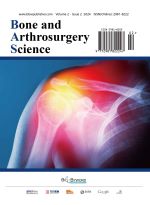摘要
Objectives: Based on anatomical knowledge of the upper cervical spine, it is necessary to be familiar with the classification, diagnosis, and treatment strategies currently used clinically for upper cervical spine injuries. Summary of literature review: Upper cervical spine injuries are major injuries with potentially fatal consequences. The occipitocervical junction, which is composed of several structures, protects the brain and cranial nerves. We need to know the mechanism of each type of damage, and in particular, we must understand the anatomy of the occiput, atlas, and axis, as well as the definitions of landmarks of the positional relationships among all structures. Materials and methods: This study reviewed the latest literature on upper cervical spine injuries. Results: In occipital condyle fractures and atlanto-occipital injuries, we should understand how to evaluate instability and the treatment methods according to each classification. In atlas injuries, it should be evaluated whether the transverse atlantal ligament has been damaged. In axis fractures, it is necessary to understand the surgical method according to the shape of the odontoid fracture. Conclusions: Knowledge of soft tissue and bony structural relationships in the upper cervical spine is required for the diagnosis and treatment plan of upper cervical injuries.
参考
Dagtekin A, Avci E, Hamzaoglu V, et al., 2018, Management of Occipitocervical Junction and Upper Cervical Trauma. Journal of Craniovertebral Junction and Spine 9(3): 148–155. http://doi.org/10.4103/jcvjs.JCVJS_72_18
Kasliwal MK, Fontes RB, Traynelis VC, 2016, Occipitocervical Dissociation—Incidence, Evaluation, and Treatment. Curr Rev Musculoskelet Med, 2016(9): 247–254. http://doi.org/10.1007/s12178-016-9347-6
Offiah CE, Day E, 2017, The Craniocervical Junction: Embryology, Anatomy, Biomechanics and Imaging in Blunt Trauma. Insights Imaging, 8(1): 29–47. http://doi.org/0.1007/s13244 016-0530-5
Swartz EE, Floyd RT, Cendoma M, et al., 2005, Cervical Spine Functional Anatomy and the Biomechanics of Injury Due to Compressive Loading. J Athl Train, 40(3): 155–161.
Jr Harris JH, Carson GC, Wagner LK, 1994, Radiologic Diagnosis of Traumatic Occipitovertebral Dissociation: 1. Normal Occipitovertebral Relationships on Lateral Radiographs of Supine Subjects. AJR Am J Roentgenol, 162(4): 881–886. http://doi.org/10.2214/ajr.162.4.8141012
Alves OL, Pereiram L, Kim SH, et al., 2020, Upper Cervical Spine Trauma: WFNS Spine Committee Recommendations. Neurospine, 17(4): 723–736. http://doi.org/10.14245/ns.2040226.113
Cronin CG, Lohan DG, Mhuircheartigh JN, et al., 2009, CT Evaluation of Chamberlain’s, Mc Gregor’s, and McRae’s Skull-Base Lines. Clinical Radiology, 64(1): 64–69.
Graber MA, Kathol M, 1999, Cervical Spine Radiographs in the Trauma Patient. Am Fam Physician, 59(2): 331–342.
Anderson PA, Montesan PX, 1988, Morphology and Treatment of Occipital Condyle Fractures. Spine, 13(7): 731–736. http://doi.org/10.1097/00007632-198807000-00004
van der Burg SJ, Pouw MH, Brink M, et al., 2020, Clinical Relevance of Occipital Condyle Fractures, Journal of Craniovertebral Junction and Spine, 11(3): 173–179. http://doi.org/10.4103/jcvjs.JCVJS_100_20
Kasliwal MK, Fontes RB, Traynelis VC, 2016, Occipitocervical Dissociation—Incidence, Evaluation, and Treatment. Curr Rev Musculoskelet Med, 2016(9): 247–254. http://doi.org/10.1007/s12178-016-9347-6
Kazemi N, Bellabarba C, Bransford R, et al., 2012, Incidence of Blunt Cerebrovascular Injuries Associated with Craniocervical Distraction Injuries. Evid Based Spine Care J, 3(4): 63–64. http://doi.org/10.1055/s-0032-1328145
Woods RO, Inceoglu S, Akpolat YT, et al., 2018, C1 Lateral Mass Displacement and Transverse Atlantal Ligament Failure in Jefferson’s Fracture: A Biomechanical Study of the “Rule of Spence.” Neurosurgery, 82(2): 226–231. http://doi.org/10.1093/neuros/nyx194
Li L, Teng H, Pan J, et al., 2011, Direct Posterior C1 Lateral Mass Screws Compression Reduction and Osteosynthesis in the Treatment of Unstable Jefferson Fractures. Spine, 36(15): E1046–E1051. http://doi.org/10.1097/BRS.0b013e3181fef78c
Fielding JW, Hawkins RJ, 1977, Atlanto-Axial Rotatory Fixation. (Fixed Rotatory Subluxation of the Atlanto-Axial Joint). J Bone Joint Surg, 59(1): 37–44.
Carvalho AD, Figueiredo J, Schroeder GD, et al., 2019, Odontoid Fractures: A Critical Review of Current Management and Future Directions. Clinical Spine Surgery, 32(8): 313–323. http://doi.org/10.1097/BSD.0000000000000872
Grauer JN, Shafi B, Hilibrand AS, et al., 2005, Proposal of a Modified, Treatment Oriented Classification of Odontoid Fractures. The Spine Journal, 5(2): 123–129. http://doi.org/10.1016/j.spinee.2004.09.014
Kandziora F, Schnake K, Hoffmann R, et al., 2010, Injuries to the Upper Cervical Spine. Part 2: Osseous Injuries. Der Unfallchirurg, (113): 1023–1041. http://doi.org/10.1007/s00113-010-1896-3
Effendi B, Roy D, Cornish B, et al., 1981, Fractures of the Ring of the Axis. A Classification Based on the Analysis of 131 Cases. J Bone Joint Surg Br, 63-B(3): 319–327. http://doi.org/10.1302/0301-620X.63B3.7263741
Levine AM, Edwards CC, 1985, The Management of Traumatic Spondylolisthesis of the Axis. J Bone Joint Surg Am, 67(2): 217–226.
Schleicher P, Scholz M, Pingel A, et al., 2015, Traumatic Spondylolisthesis of the Axis Vertebra in Adults. Global Spine J, 5(4): 346–357. http://doi.org/10.1055/s-0035-1550343
